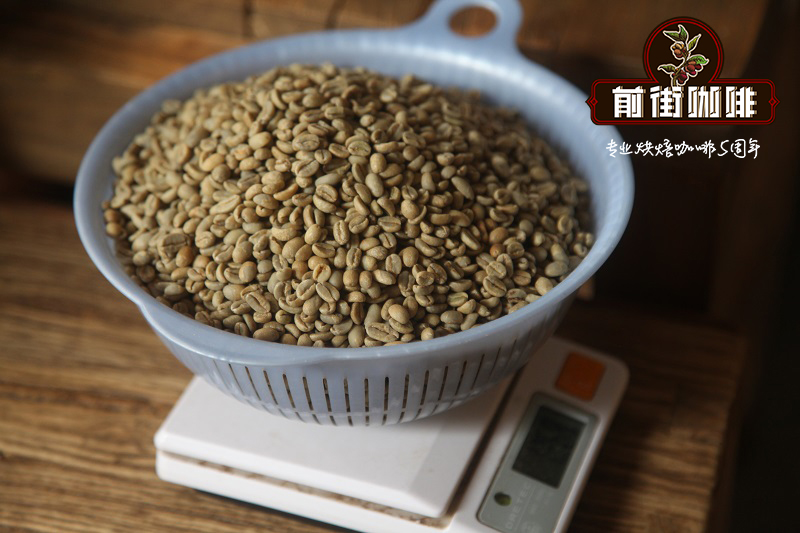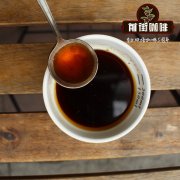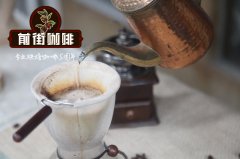Is there a story about Sumatran coffee? how much is Sumatran coffee? how much is Sumatran coffee beans?

Professional coffee knowledge exchange more coffee bean information please follow the coffee workshop (Wechat official account cafe_style)
The source of Manning
The main producing areas of Indonesian coffee are Sumatra, Java and Sulawesi, among which Sumatra coffee bean "Mantenin" is the most famous.
Lintong is also known as Sumatran Coffee, Lake Tawa at the north end can be called Aceh Coffee or Lake Tawa Coffee, and the area between Lindong Coffee and Lake Toba can be called Manning.
Mantenin has a strong taste, with a strong mellow and rich and lively sense of movement, neither astringent nor sour, mellow and bitter can be fully revealed. The appearance of Mantenin coffee beans is arguably the ugliest, but coffee fans say that the worse the Sumatran coffee beans are, the better, mellow and slippery they are.
Manning's unique wet planing method
Wet planing, also known as wet shelling Wet Hulling, also known as Giling Basah in the local language, is a traditional Indonesian coffee treatment. Judging from the name alone, the wet planing method is very similar to the wet treatment (water washing treatment). However, the cup flavor of the two treatments is very different. The coffee treated by the wet planing method is usually mellow and strong, and the personality is very distinct.
Steps of wet planing treatment
① removes peel and pulp and retains parchment and mucous membrane.
② tank fermentation
③ washing off mucous membrane
④ with parchment is sun-dried for 2-3 days to 20-24% moisture content.
⑤ scraped off the parchment
⑥ dries raw beans to 12-13% moisture content.
⑦, prepare for exit.
Why do you use wet planing?
a. Climatic reasons
The tradition of using wet planing in Indonesia starts with the local weather. Humidity in Indonesia is between 70 and 90 percent all year round, typhoons continue, and in some areas, annual rainfall can reach as much as 2000mm. You know, raw beans are most afraid of Rain Water. How did Indonesia overcome such bad weather conditions to produce rich and mellow Mantenin coffee? That is to rely on wet planing.
In tropical climates, coffee takes an average of 2-3 weeks to dry. In such a humid climate in Indonesia, dry coffee has become a big problem. Coffee must take longer to dry, during which time the coffee still maintains a high humidity, making it easier for bacteria to soak into raw coffee beans.
In the process of ordinary washing, the drying process is carried out with parchment to protect raw beans from external damage to a certain extent. However, we can note that the wet planing removes the parchment for the final step of drying, so that the sun shines directly on the surface of the raw beans, causing the coffee beans to dry quickly, 2-3 times faster than washing.
b. economic performance
In the 17th century, Dutch colonists first introduced coffee to Indonesia. This group of colonists sought more and faster economic returns. Wet planing greatly shortened the time spent on the farm and greatly reduced the cost of labor. This coincides with the mentality of investors who pursue quick profits and reduce costs. This is also a reason to promote the wet planing method.
c. Defects and kuku kambing (Bauhinia)
When the parchment is removed by wet planing, the water content of coffee is still as high as 20-24%, while in general treatment, the water content of coffee is reduced to 10-12% before shelling. In the "semi-dry" state, parchment will adhere to the surface of raw beans, removing parchment is more difficult than "fully dry", and the shelling process requires more friction.
But on the other hand, "semi-dry" raw coffee beans are very fragile at this time, far less hard than "fully dry" raw beans, so beans are more likely to be squeezed and form a small gap. This is what we often call horseshoes or sheep's hoof beans (locally known as kuku kambing).
The super speed of wet planing also causes Manning to have higher defects. Employees will be arranged to carry out manual selection of defects in the processing plant, usually with DP (second hand selection) and TP (third hand selection). After three times of hand selection, Mantenin will be better than the second hand selection in the defect rate.
Summary:
To sum up the flavor of the wet planer, apart from those slight differences, we generally think that the wet shaved bean has the taste of soil, tobacco and chocolate, and the sour taste is called "low acid", mellow and dull.
Low acid comes from a shorter, weaker fermentation process and a longer drying time, if you forget the wet plane fermentation, turn back and have a look. As for the "earthy taste" of wet shaved beans, there are different opinions. Some people say that this is related to the beans selected in the wet planing-related producing areas (Tim & Kadim: with Rob pedigree), some people say that this is the result of the organic interaction between raw beans and the outside world, and some even say that it is because there are too many defective beans! Of course, there are a lot of...
What is Golden Manning?
Some friends who opened a coffee shop a few years ago said that "golden manning" is an old manning. When it comes to Golden PWN, the acronym is often mixed with the name of Manning Coffee, which is actually a company's acronym Pwani Coffee Company.
This company is a very famous local coffee acquisition company in Indonesia, mainly buying Mantenin Coffee. It has acquired almost all the best producing areas in Indonesia, so most of the beans produced by PWN are unique boutiques. Gold Mantning is the product produced by this company. After the acquisition of raw beans, the beans are selected by hand to select the full and flawless beans. Finally, these beans can be divided into Golden Manning as if they had gone through the draft.
However, PWN registered the gold manning as a trademark, that is to say, only the gold manning produced by PWN can be regarded as the real "golden manning". Many of the beans on the market that are not made by PWN and hang the gold manning brand should actually be called boutique manning.
"Golden Manning", it is not an old bean, but a product named by the company.
The difference between [Manning and Golden Manning]:
A brown friend asked, "I'm a beginner in coffee. What's the difference between this golden manning and Manning G1? I really can't drink it." For professional coffee diners and taste-sensitive coffee lovers, if you drink these two types of coffee at the same time, the result will be very obvious. Huang Man's sweetness and cleanliness, mellow, wild spice flavor are slightly better than G1, which is one of the reasons why Huangman is much more expensive than G1.
Manning needs layers of screening, which I think is absolutely necessary. The probability of defective beans is too high, coupled with the ugly appearance, sometimes good beans look like defective beans. Every time I pick Mantenin, I can pick out a handful of defective beans, look back in the defective beans, and feel that it is not defective beans, it looks like this. However, after baking, Mantenin is like a caterpillar breaking its cocoon into a butterfly. The ripe beans are very full and look quite pleasing to the eye.
And gold Mantenin defect rate of 2%, very beautiful.
What kind of beans is old gold manning?
As a matter of fact, old coffee has a long history in Indonesia, because the early shipping is not so developed, and it takes a long time to transport coffee from Indonesia to other countries.
The slow drying of coffee beans coupled with the blowing of the sea breeze adds a very special flavor. Due to the progress of modern shipping, transportation time has been greatly reduced, so coffee with a special flavor like this has become a specially processed coffee bean.
The treatment of aged beans is a technology, which must be closely monitored during the aging process of coffee beans, the dry humidity and temperature of the warehouse have standard requirements, and coffee raw beans should be flipped irregularly, so as to avoid the drop or mildew between the upper and lower dry humidity. The aging process is not to make it lose its flavor, but to create another flavor, and a pleasant flavor.
Four kinds of Manning were collected, which are:
Golden Manning Gold Mandheling
SumatraIsland, Mandehling Longberry, Timtim Belangele (timtim Mantenin)
Lin Dong Manning G1 Lintong Mandheling Grade-1
Emerald Manning (Aceh, Aceh province, Sumatra)
Photos of raw beans
Image above: gold Manning Gold Mandheling semi-washed raw beans
Image above: horse Manning full-sun raw beans, which are crossed between Arabica and Robusta, called Timor and timtim in Indonesia.
Image above: Lin Dong Manning G1, although the grade is Grade-1, it is still difficult to change the characteristics of high defect rate of Indonesian beans, about 8% of defective beans.
Image above: Emerald Manning (Aceh, Aceh, Sumatra), 19 mesh +, raw beans are green and full, glittering and translucent, like an emerald
The Gayo Mountains are located in the Aceh-producing region of the northern province of Sumatra, where most of the coffee farmers working in Gayo are local farmers. The word "Gayo" comes from the tribes of Aceh in Indonesia. This area has ideal growth conditions, long history and culture and unique flavor. The region widely uses organic methods to grow coffee without chemical fertilizers, and is considered to be the world's green coffee production region. Therefore, Gayo coffee is often called green coffee and Gayo organic coffee.
Sumatran coffee is a wonderful presence in the boutique coffee system. You see, the famous Mantenin, in fact, it is not the name of the producing area, nor is it the name of coffee beans, and even the sources of its beans are so messy.
Ateng--
It is a hybrid between Arabica and Robusta, with several subtypes, widely cultivated in Sumatra and other Indonesian islands. To put it bluntly, it is a branch of Catimor (Katim). Ateng is a local name.
Djember--
Djember is a place name in Sumatra checked by Baidu. It looks like a mystery, but in fact, the breed is Smuri 795. Because the bean seed was spread to the island by Jember Coffee Reseach Center, the local people call it this name.
What is Smur795? It was developed by Indian botanists crossing the tin card mutant Kent (Kent) with Smuri 288.
What is Smur288? It is a natural hybrid of Arabica and Liberica.
TimTim--
Timor Hybrid, which translates to East Timor hybrid, that is, the hybrid of Arabica and Robusta. The familiar Catimor is hybridized with it again.
Tim Tim---- horse face Manning longberry
Tim Tim is a bean from Indonesia. Because of its long shape, many people call it Ma Mian Dou, and some people call it long Manning. In fact, tim tim is not a purebred bean, but a natural cross between Arabica coffee and Robusta coffee, which was discovered on the island of timor in the 1940s and cultivated for its natural disease resistance. In America this variety is called Hybrido de Timor, or Tim Tim for short, and in Indonesia it is also called Bor Bor.
Manning's baking
Compare the three baking degrees of light baking, medium-deep baking and deep baking.
Choice of appliances: Hario V60
Steaming time: 25 seconds
1. Light baking: small Fuji ghost teeth grinding 3.5, water temperature 90 degrees, gouache ratio 1:15
2. Medium and deep baking: small Fuji ghost tooth grinding 4, water temperature 88 degrees, gouache ratio 1:15
3. Deep baking: small Fuji ghost teeth grinding 4.5, water temperature 86 degrees, gouache ratio 1:15
Test result
1. Light baking: the fruit acid is obvious, but the entrance is very comfortable, slightly bitter, there is a feeling of health on both sides of the mouth, smooth feeling in general.
2. Medium-deep baking: the sense of balance is very good, rich and mellow, bitterness is obvious, chocolate and slight sweetness are more prominent, licorice fragrance is obvious, smooth feeling is better than light, and the aroma is strong.
3. Deep baking: almost no sour taste, very bitter taste, slightly improper baking will produce the smell of burning.
What are the main problems of over-extraction or insufficient extraction?
The phenomenon of over-extraction: coffee is too bitter because the coffee powder has been soaked in water for too long.
The phenomenon of insufficient extraction: the taste is thin, feeling that water and coffee are separate.
Different utensils and different cooking methods
The taste will be different.
Hand punch
1. Filter cup: Hario V60
two。 Water temperature: 88 degrees
3. Degree of grinding: small Fuji degree of grinding 4
4. Baking degree: medium and deep baking
5. Steaming time: 25 seconds
Flavor: changeable levels, clean, balanced, long-lasting caramel sweetness
Specific techniques: 15g powder, small Fuji ghost tooth cutter 4 grinding, V60 filter cup, 88-89 degrees water temperature, 30g water injection for the first time, 25 s steaming, water injection to 104g water cut off, waiting for the powder bed water to go down to half and then water injection, slow water injection until 220g water, 5 grams at the end, no water powder ratio at 1:15, extraction time about 2:00
Philharmonic pressure (Aeropress)
1. Water temperature: 85 degrees
two。 Degree of grinding: small Fuji 3.5
3. Baking degree: medium and deep baking
4. Steaming time: 2 times, the first time 20 seconds, the first time 50 seconds
Specific techniques: Philharmonic pressure positive pressure preparation, it is recommended to add 20 grams of coffee powder, gouache ratio at 1:17, first into 83 degrees hot water 100g, stir three to five times to make coffee powder fully wetting, static for 20s, add remaining hot water to 240g, rest for 40s, stir for 5s, wait until 1 minute 50 seconds up and down pressure, the total time is 2 minutes 5 seconds.
Flavor: full-bodied, complex, outstanding spice, forest fragrance
Siphon
1. Water temperature: 90 degrees
two。 Degree of grinding: small Fuji 3.5
3. Baking degree: medium and deep baking
4. Steaming time: 30 seconds
Specific techniques: side-fired extraction, it is recommended that 20 grams of powder for 2 parts, gouache ratio at 1:12, water scale 2, add powder after use, drop powder after blistering, stir 4-5 times, extract for about 30 seconds, and finally, stir 2 times, wait for the coffee liquid to fall freely.
Flavor: round, full-bodied, herbs and bitterness, accompanied by caramel sweetness
Sumatra coffee bean brand recommendation
The Sumatran Mantenin coffee beans baked on Qianjie Coffee are fully guaranteed in terms of brand and quality. And more importantly, the performance-to-price ratio is extremely high, a pack of 227 grams, the price is only 89 yuan. According to the calculation of 15 grams of powder per cup of coffee, 15 cups of coffee can be made in a bag, which costs only about 6 yuan per cup, which is recommended by conscience compared to the price sold in cafes for dozens of yuan a cup.
Important Notice :
前街咖啡 FrontStreet Coffee has moved to new addredd:
FrontStreet Coffee Address: 315,Donghua East Road,GuangZhou
Tel:020 38364473
- Prev

The Mystery of Sumatra Coffee Varieties The Real Reason for Price Differences in Sumatra Coffee Beans
Professional coffee knowledge exchange More coffee bean information Please pay attention to coffee workshop (Weixin Official Accounts cafe_style) Iron pickup variant? Sumatra coffee beans-mantenin coffee varieties mystery Indonesia coffee is mainly produced in Sumatra, Java and Sulawesi, of which Sumatra produced by the most famous mantenin. Mantenin, aka Sumatra coffee.
- Next

Sumatran ground Coffee Flavor Sumatran Coffee good Sumatran Coffee Price list
For more information on coffee beans, please follow the coffee workshop (Wechat official account cafe_style) Sumatran Coffee beans-Manning is not the name of the producing area, place, port, or variety of coffee, but how it got its name is actually a phonetic mispronunciation of the mandheling people in Mandaining, Indonesia. Manning Coffee in Japan during World War II
Related
- Does Rose Summer choose Blue, Green or Red? Detailed explanation of Rose Summer Coffee plots and Classification in Panamanian Jade Manor
- What is the difference between the origin, producing area, processing plant, cooperative and manor of coffee beans?
- How fine does the espresso powder fit? how to grind the espresso?
- Sca coffee roasting degree color card coffee roasting degree 8 roasting color values what do you mean?
- The practice of lattes: how to make lattes at home
- Introduction to Indonesian Fine Coffee beans-- Java Coffee producing area of Indonesian Arabica Coffee
- How much will the flavor of light and medium roasted rose summer be expressed? What baking level is rose summer suitable for?
- Introduction to the characteristics of washing, sun-drying or wet-planing coffee commonly used in Mantenin, Indonesia
- Price characteristics of Arabica Coffee Bean Starbucks introduction to Manning Coffee Bean Taste producing area Variety Manor
- What is the authentic Yega flavor? What are the flavor characteristics of the really excellent Yejasuffi coffee beans?

